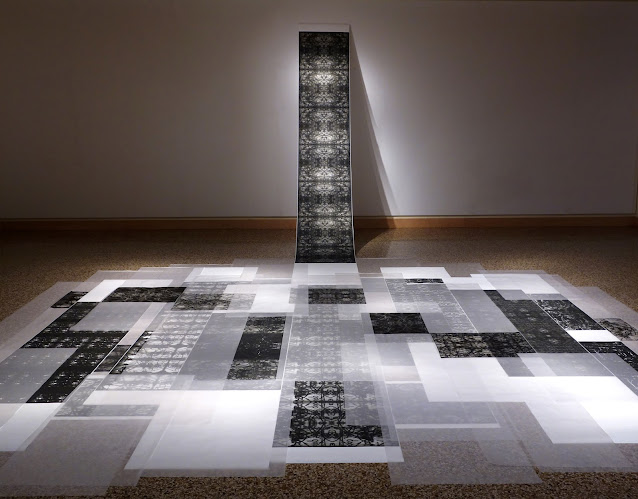 |
Map of Saranac Lake and Surrounding Area, 1954
India Ink on BFK Rives Paper, 42.5"x 53", 2019
|
It's been a great fun to share my work besides such talented artists that I admire so much. It's hard to believe that a month already went by. Today is the last day for "Charting the World: Subjective Map Making" at the Suffolk University Gallery. What a great ride it has been!
Charting the World: Subjective Map Making
January 30 - February 27, 2020
Suffolk University Gallery
8 Ashburton Place, Boston, MA
What we call the 'world'... is not given as self-evident from the
outset. It is apprehended...in an ongoing 'crisis' of spatial
consciousness. E. Cassirer
For centuries, we have used maps to chart the world - from the body to
the stars and everything in between. Both foreign and familiar, we can
both lose and find ourselves. Mapping is a way of using spatial
reasoning. Many contemporary artists use maps or refer to them in some
way to inform their work: Google maps, imaginary maps, mind maps, genome
mapping, data visualization, historical maps. The results are often
reflective and personal. Questions abound: What is the meaning of a map
in 2020? How has that changed with the abundance of possibilities
available by way of our devices? How do we find the way to each other
and back to ourselves?
Participating Artists:
In this exhibit
Naoe Suzuki is represented by two bodies of work. In her
Extinction Studies series,
she researches maps of the Adirondack region and traces animals' names
from the maps. On these maps, she was fascinated by finding so many
places with animal names, such as "Little Otter Pond" or "Salmon River."
Floating in the sea of blackness, these names become stars in the sky,
constellations, and ghosts of memories of places she holds dear. The
Water Is Taught by Thirst series
was created by tracing waterways from topographical maps. The waterways
were laser cut, leaving behind a crackled, sculptural terrain, evoking a
sense of loss.
Kate McLean works
at the intersection of human-perceived smellscapes, cartography and the
communication of 'eye-invisible' sensed data. To achieve this, she
leads public smellwalks internationally and translates the resulting
data using digital design, watercolor, animation, scent diffusion and
sculpture into smellscape mappings. Smells form part of our knowing, but
are elusive, often disappearing before they can be pinned down. Smell
experience is an invisible and currently under-presented dataset with
strong connections to emotions and memory.
Heidi Whitman's drawings
are cartographies of the subconscious that refer to time and memory as
uncharted territory. She is interested in states of mind, how experience
is translated into thought, and how dreams jumble reality. Maps of
ancient ruins and contemporary cities are part of a layered network of
pathways, spirals, and switchbacks that conflates the concrete world
with the invisible mind. Each
Mental Map drawing is constructed with layers of hand-cut paper, ink, and gouache.
Born in Taipei Taiwan,
Yu-Wen Wu's subjectivity
as an immigrant is central to her practice. Human migration and climate
change are the defining issues of Wu's work. At the crossroads of art,
science, politics and cultural issues, her wide range of projects
include large-scale drawings, site-specific video installations,
community engaged practices and public art.
Deb Todd Wheeler's recent work,
Radio Silence is
a geo-located guided audio walk at Lost Pond Sanctuary in Brookline,
MA. In a time before the world began to collapse around her, with the
sudden death of her son and the suicide of her brother and in the depths
of grief in 2019, she set out to record a group of songs with the
LENNYcollective. For the artist, it became a healing journey, a walk
through the soundtrack of her life. She says "this walk is for all of us
who walk the wild edge of sorrow."
Teri Rueb's work combines sound and site using mobile media. One of the works represented in the exhibit
Fens, is
composed mainly from location recordings made in the Boston Back Bay
Fens in different seasons, different weather, at different times of day
and night. Inspired by Fredrick Law Olmsted's fascination with parks as
confluences of natural and social processes, the piece takes up
landscape as a site of interaction between human and non-human elements
evoked through sound. The other
Core Sample, is a GPS-based
interactive sound walk and corresponding sound sculpture that evokes the
material and cultural histories contained in and suggested by the
landscape of Spectacle Island. The piece engages the extended landscape
of Boston Harbor as bound by the Institute of Contemporary Art building
on the Seaport waterfront, and Spectacle Island, a former dump and
reclaimed landfill park visible just off the coast.
The exhibit is curated by Deborah Davidson.















